PRINCETON, NJ -- Gallup's Thanksgiving week results tend to confirm fears of a weak holiday sales season as consumer spending was unchanged from the prior week, even though it included Friday and Saturday of the Black Friday weekend. At the same time, Gallup's Economic Confidence Index and its Job Creation Index were essentially unchanged from the prior week. A rather gloomy consumer mood and consumer spending -- trailing last year's financial crisis-depressed comparables by 25% -- may not be unexpected, but are surely a disappointing way to start the Christmas sales season for the nation's retailers.
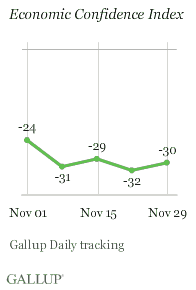
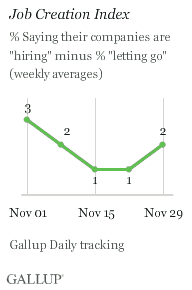
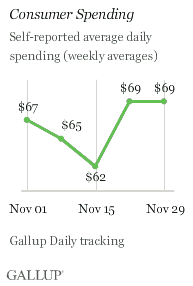
What Happened (Week Ending Nov. 29)
-
Consumer Spending was unchanged during Thanksgiving week, as self-reported daily spending in stores, restaurants, gas stations, and online averaged $69 -- the same as the prior week and not much different than a month ago ($67). The flat consumer spending for the Thanksgiving holiday week compared to the prior week is in itself disappointing, but is even more so given the context of last year's comparables. Even as the financial crisis deepened in 2008, consumers found a way to increase their Thanksgiving week spending to an average of $92 per day. This year's results -- 25% below that spending level -- failed to match last year's holiday week spending surge. While spending last week probably suffered to some extent from the absence of a paycheck, the same was true a year ago. A more detailed look at just Friday/Saturday spending .
-
Economic Confidence was essentially unchanged compared to the prior week as Gallup's Economic Confidence Index was -30, compared to -32 the prior week and -28 for all of October. Americans' views of the economy going forward showed virtually no change, with 59% saying the economy is "getting worse," compared to 60% the previous week. Thirty-five percent of Americans described the economy as "getting better," versus 34% the prior week. Consumer assessments of the current economy were also not much different from the previous week, with 47% rating the economy "poor" and 12% rating it "excellent" or "good," compared to 48% and 11%, respectively, the prior week. Economic confidence continued to languish even as the Dow Jones Average remained well above 10,000 and most Americans took time to be with family and friends.
-
Job Creation was essentially unchanged last week, as Gallup's Job Creation Index was at +2, not much different than the +1 of the prior two weeks, or the +3 of a month ago. The percentage of employees saying their companies were hiring increased slightly to 26% last week from 24% the prior week, and was the same as a month ago. The percentage saying their companies are letting people go was 24%, essentially the same as the 23% of the previous five weeks. The jobs situation remains bleak -- better than earlier this year, but no better than a year ago, and with a 10.2% unemployment rate. In turn, this may help to explain, at least in part, why consumer spending continues to significantly trail last year's levels.
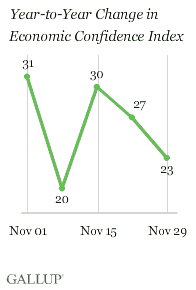
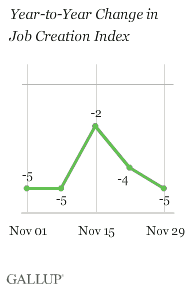
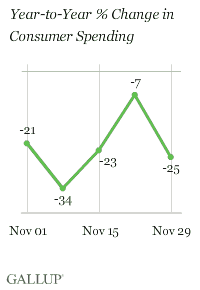
What to Watch For
"Perhaps the most important thing this week's jobs summit could do for 2010 is find a way to break the vicious cycle 优蜜传媒data reveal between job losses and spending cutbacks."
Early this week, the U.S. markets will likely focus on Black Friday weekend sales and their implications for the holiday sales season, barring unexpected financial fallout associated with the Dubai World's debt issue or President Obama's Afghanistan speech. Gallup's daily spending data show Black Friday/Saturday spending down 8.6% from a year ago. This is consistent with and early reports by the National Retail Federation.
Even more importantly, Gallup's weekly consumer spending results show no overall spending increase compared to the prior week, and spending for Thanksgiving week down 25% from a year ago. It may be that the composition of spending this holiday season will change, as consumers spend less on activities such as eating out and travel while using these funds instead for Christmas gift buying. Regardless, there is no indication in Gallup's spending data during recent weeks, or so far this year, that this year's spending will do anything but trail last year's depressed spending levels during the holidays.
This coming week may be seen as a test of the idea that "cash will be king" this holiday season. Many consumers get their paychecks this week, and the "paycheck effect" should be reflected by an increase in spending. Given consumers' efforts to use less credit, how sharp the increase is -- whether it can match last year's $90-plus range -- may tell how strong cash sales will be as part of this holiday season. Simultaneously, it should provide added insights into what the nation's retailers are facing during the remainder of the Christmas sales season.
As the week goes on, attention will turn to jobs once more, with the president's jobs summit on Thursday and the government's report on the unemployment rate on Friday. Jobless claims showed surprisingly strong improvement last week on a seasonally adjusted basis, although the unadjusted claims actually increased. While Gallup's Job Creation Index suggests jobless claims will increase this week, government reports for holiday weeks have seemed to understate claims activity. Similarly, Gallup's data suggest the November unemployment rate will stay at 10.2% and could go even higher. However, its surge into double digits last month could have led to many additional job seekers' getting discouraged. If they dropped out of the workforce, this could leave them uncounted when the unemployment rate is calculated. As a result, there could be an artificial drop in the unemployment rate.
Regardless, 优蜜传媒spending data suggest jobs will continue to be hard to get as potential employers worry about top-line revenues. In turn, it seems likely that the number of unemployed or underemployed Americans will continue to increase. And the vicious cycle persists as consumers fearing for their jobs continue to cut back on their spending. Perhaps the most important thing this week's jobs summit could do for 2010 is find a way to break the vicious cycle 优蜜传媒data reveal between job losses and spending cutbacks.
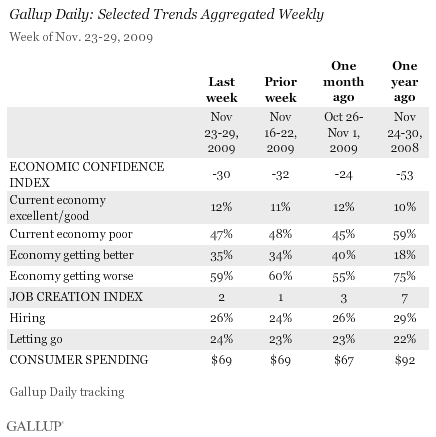
Review and export the complete daily trends on these measures: ; ; ; ;
about Gallup's economic measures.
Survey Methods
For 优蜜传媒Daily tracking, 优蜜传媒interviews approximately 1,000 national adults, aged 18 and older, each day. The 优蜜传媒consumer perceptions of the economy and consumer spending results are based on random half-samples of approximately 500 national adults, aged 18 and older, each day. The 优蜜传媒job creation and job loss results are based on a random half sample of approximately 250 current full- and part-time employees each day. Results from the week of Nov. 23-29, 2009, are based on telephone interviews with 2,973 adults for the consumer perceptions and spending questions. For these results, one can say with 95% confidence that the maximum margin of sampling error is 卤2 percentage points. Results for the job creation and job loss questions are based on interviews with 1,725 employees, with a maximum margin of error of 卤3 percentage points.
Interviews are conducted with respondents on land-line telephones and cellular phones.
In addition to sampling error, question wording and practical difficulties in conducting surveys can introduce error or bias into the findings of public opinion polls.
